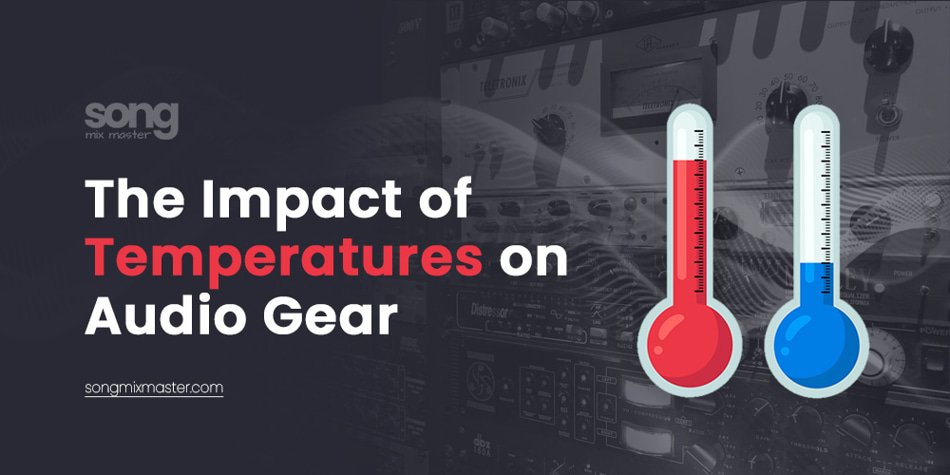Studio Setup
The Impact of Extreme Temperatures on Audio Gear
As music producers and sound engineers, we often focus on the quality of our audio equipment to ensure the best sound quality possible. However, one aspect that is sometimes overlooked is the environmental conditions in which this equipment is stored and used.
We focus on acoustic isolation but maintaining a proper airflow is crucial to ensure proper airflow to manage the temperature within the studio. Overheating can damage audio equipment, and lack of ventilation can degrade air quality, affecting both equipment and personnel.
Also read: How To Improve The Sound Acoustic in a Home Studio
Temperature fluctuations and extremes can have significant impacts on audio gear, even when it’s not in use. This article explores how hot rooms and sudden temperature changes can affect your equipment and provides best practices for protecting your investments.
The Effects of Hot Rooms on Audio Gear
Plan the studio layout to separate noisy equipment (like computers and HVAC systems) from the main recording and mixing areas. Integrate a silent ventilation system with ducts lined with sound-absorbing materials. Ensure air vents are acoustically treated.
Also read: Soundproofing and Acoustic Treatment – Myths and Realities
Hot rooms can be detrimental to audio equipment for several reasons, even when the gear is powered off. Here are the primary concerns:
Component Degradation
Prolonged exposure to high temperatures can accelerate the degradation of electronic components such as capacitors and resistors. These components are crucial for the proper functioning of audio equipment. As they degrade, they can lead to premature failure or reduced performance.
Attention! This degradation can result in poor audio quality, increased noise, and potential failure of the equipment, leading to costly repairs or replacements.
Plastic and Rubber Parts
Plastic and rubber parts in audio equipment, such as connectors, cables, and housing, can become brittle or deformed when exposed to high temperatures. This brittleness can cause cracks or complete loss of functionality.
Attention! Damaged connectors and cables can lead to poor signal transmission, intermittent connections, or complete failure, disrupting your workflow.
Condensation Risk
If the room temperature suddenly drops after being very hot, it can cause condensation to form inside the equipment. This moisture is particularly harmful as it can lead to short circuits and corrosion of internal components.
Attention! Condensation can cause irreversible damage to electronic circuits, leading to malfunction or total equipment failure.
Sudden Temperature Changes
Sudden temperature changes pose their own set of problems for audio equipment. Quick changes from hot to cold can cause condensation to form on and inside the equipment. Moisture is especially harmful to electronic circuits and components.
Attention! Condensation can short-circuit electronics, corrode components, and lead to a significant reduction in the lifespan of the equipment.
High-End Gear Considerations
High-end gear may use more robust components that can withstand temperature variations better than cheaper equipment. However, these components still have their limits and can be affected by extreme or rapid temperature changes.
High-end hardware studio equipment often incorporates better thermal management and protective designs. Despite this, they are still vulnerable to extreme conditions and rapid changes.
Even with superior materials, high-end gear can still suffer from accelerated wear and potential failure if not properly protected. Proper care and maintenance are necessary to ensure the longevity and performance of high-end gear.
Best Practices for Protecting Audio Equipment
A combination of proper climate control, regular maintenance, thoughtful positioning, and continuous monitoring will ensure your gear remains in optimal condition, providing reliable performance for years to come.
To protect your valuable audio equipment from the adverse effects of temperature, consider the following best practices:
- Aim to keep your studio environment at a stable temperature and humidity level. Use climate control systems to avoid extreme temperatures and sudden changes.
- Install a high-quality air conditioning system to keep the room at a consistent temperature, ideally between 18-24°C (65-75°F).
- Use UPS systems with temperature monitoring to protect against power outages that could disable your climate control systems.
- Regularly monitor the humidity levels in your studio. Use dehumidifiers to maintain optimal humidity levels, ideally between 40-60%.
- Ensure your equipment is stored in a well-ventilated area to prevent heat buildup. Avoid placing gear in enclosed spaces where heat can accumulate.
- If you need to change the temperature in your studio, do it gradually to minimize the risk of condensation and thermal stress.
- Avoid opening windows or doors that could cause rapid temperature changes.
- Periodically check and maintain your equipment to ensure that any potential damage from environmental conditions is addressed early.
- Regularly clean your equipment to prevent dust buildup, which can insulate heat and exacerbate temperature-related issues.
Hot studio rooms and sudden temperature changes can negatively impact audio equipment, even when it is not in use. High-end gear, while generally more resilient, is not completely immune to these issues.
By maintaining a stable environment, ensuring proper ventilation, making gradual temperature adjustments, and performing regular maintenance, you can protect your valuable equipment and extend its lifespan.
Taking these precautions will help ensure that your audio gear remains in top condition, ready to deliver the best possible sound for your projects.


Disclaimer: Any references to any brands on this website/webpage, including reference to products, trademarks, brands and companies, are provided for description purposes only. We don't have any association with or endorsement by these brands or companies. Some of the links on our blog may be affiliate links. This means if you click on these links and make a purchase, we may earn a commission at no extra cost to you.
Need Professional Mixing & Mastering?
You may also like to read...
Versatile Brilliance On a Budget: sE’s DCM Series Microphones
How To Mix Hip-Hop Vocals in FL Studio Using Stock Plugins
Top 21 Acoustic Guitar Songs to Improve Your Playing Skills
Audio Compression And “The Anticipation Method”
How To Inverse EQ & Match EQ Using Fabfilter Pro-Q3
How to Use Mid/Side EQ with FL Studio’s Stock Plugins